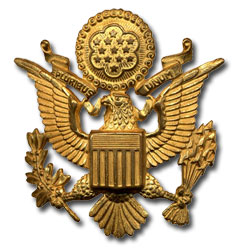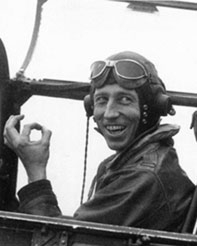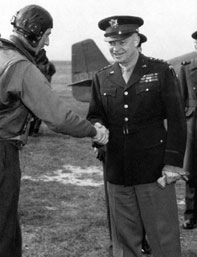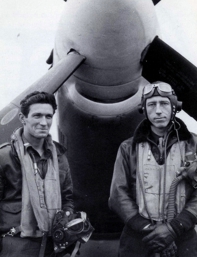Maj. James H. Howard, fighter pilot of the 9th Air Force. The Oeschersleben mission on 11 January, 1944
Howard began right here, while the squadron was in training at Salem, Oregon, to earn his next nickname, "The Whip." He was sort of a flying counterpart of that coach from the University of Michigan who earned the name of "Hurry Up" Yost. At any rate he soon had the entire personnel working so hard they forgot the hard luck stories. He taught them team work and gave them confidence. He told them that if they didn't like the airplanes they were flying at the moment, they might get better ones for combat. They did. Soon after landing in England they were assigned the "flier's own type," the Mustangs. Now the Mustang, as Major Howard explained it, originally was manufactured in small numbers for the RAF. On May 10, 1942 it made its first combat mission over an airdrome on the French coast. The pilots who shot up a freight train and two lorries on the way home were enthusiastic. But some of the others who flew it were milder in their praise. This first Mustang was a comparatively low altitude job. In the Mediterranean theater it was flown by Americans for the first time.
He says you could fly the Mustang in ordinary street clothes because it has a heater, but you go very high and you'd probably get a bit chilly.
The present model was sent here last spring. It is powered by a 1,500-horsepower Packard manufactured Rolls Royce Merlin engine, includes a two stage, two-speed supercharger for altitude, has an updraft carburetor, a four-bladed propeller, and racks under each wing capable of carrying either 500-pound bombs or drop tanks which can hold seventy-five gallons apiece. It has what the pilots say is a "terrific design," and they claim it is the fastest airplane in the world. Of course they understand that almost every American pilot believes his fighter, whatever it is, should have that distinction. But they still say it about the Mustang. Four out of five of all the aviators who told me their personal combat experiences at this post wound up by saying something like this: "But, gee! It wasn't me that did the work that counted for that bugger. It was the airplane."
When Major Howard gets in his ship, which is appropriately entitled and emblazoned "Ding Hao," which means "Very good," they have to put his foot rests up and his seat back so he'll be comfortable. He flies with ordinary uniform trousers, a shirt, sweater and yellow "Mae West" life preserver, flying boots, gloves, helmet and goggles. He says you could fly the Mustang in ordinary street clothes because it has a heater, but you go very high and you'd probably get a bit chilly.
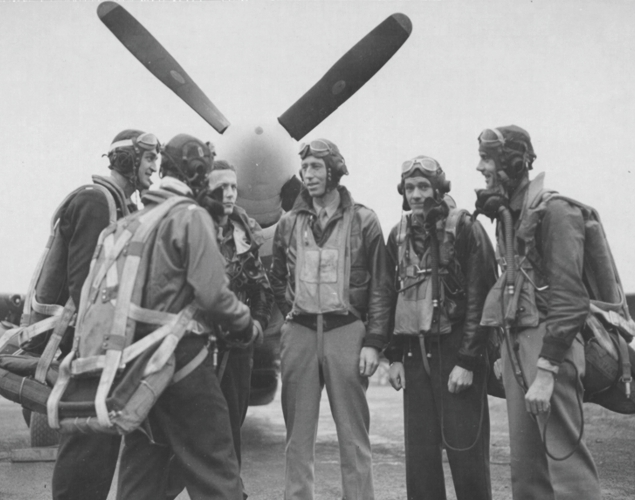
Based at Boxted , England, pilots chat informally before take-off on a long mission over enemy territory. They are, left to right: 1st Lt. Franklyn E. Hendrickson, 1st Lt. William E. Pitcher, 2nd Lt. Edward E. Phillips, Major James Howard, 2nd Lt. Loren E. Long, and 2nd Lt. Glendon J. Buer. 20 January 1944.
"We have gone on seventeen missions already," he said. "You'll be here when we go on the eighteenth. You can go to the briefing for the trip, watch us take off, listen to the radio as we go into combat, sit in on the intelligence reports when we return and then see the combat films which are made simultaneously with the firing of the guns."
He explained that the first few missions had been light operations over northern France. Then on December 11, 1943, they had escorted bombers to Emden. Two days later they went to Kiel, which was the longest fighter trip in world history, only the public wasn't let in on the secret.
He added, "This ship has no bugs. All the pilots have gone overboard for it. They wouldn't want to have to select any other plane to fight in. And we'd all like to race the Mosquito, the Typhoon, the Spitfire, P-38, P-47, or the German Focke-Wulf or Messerschmitt 109."
As we strolled over to the lounge to see films of the famous battle of January 11, Major Howard rounded out the statistics on the Mustang. It weighs about 9,000 pounds, is thirty-two feet eight inches long, thirteen feet eight inches high and has a wing span of thirty-seven feet. Those distinctive propellers have blades eleven feet two inches long. Names painted on ships I saw included "Peg O My Heart," on the ship of Maj. George R. Bickell, of Nutley, N.J., a former brokerage clerk; "Killer," on that of Lieut. Robert W. Stephens, a former professional baseball player, of St. Louis; "Marionette," on the Mustang flown by Lieut. William P. Nacy, of Jefferson City, Mo., a one-time bank bookkeeper; "Duration Plus," on that of Lieut. Harry E. Fisk, once a railway employee of Spokane, Wash., and "Cisco," on the ship flown by a former member of the RAF, Lieut. Donald D. Nee, of Whittier, Calif.
The film unrolled and even a novice could see that many of the Nazis which Major Howard didn't claim probably never would fly again. The tracer bullets which showed up so clearly were only fired every fifth shot. You were impressed by the accuracy of the major's shooting. He fought at such close quarters that at times the image of the enemy plane was larger than the film. He truly had swept the skies clean.
Here is his own story of the fight in his own words:
Our group was assigned to provide target support for boxes of bombers. "A" squadron was sent to the forward box and I later discovered that this was where all the activity was centered, but at the time I was unable to do anything about it. I just had to use what fighters I had to the best advantage that I could. The bombers passed over the target and there we met our first attacks. Flights of Mustangs were dispatched to engage the attacking enemy aircraft and I began attacking with my flight. On the first encounter, which turned into a melee, my flight lost me, the newspapers headlined "I got lost and I got busy." Well, that wasn't quite accurate. Because, naturally, in a fight like that, you can get separated from the other fellows and that's what happened. But I just don't get lost and neither do our other pilots. When I regained bomber altitude, I discovered I was alone and in the vicinity of the forward boxes of bombers. There was one box of B17's in particular that seemed to be under pressed attack by six single and twin-engine enemy fighters. There were about twenty bombers in a very compact formation and the fighters were working individually.
But you can be sure I never stopped what I was doing to count them. In slang words, I just seen my duty and done it.
The first plane I got was a two engine night fighter. I went down after him, gave him several squirts and watched him crash. He stood out very clearly, silhouetted against the snow that covered the ground. I guess we might have been over Magdeburg. Anyway we were over or nearly over some German town. I could follow that fellow down because with the snow on the ground like that you don't have to worry about miscalculating distance in figuring out the proximity of the earth. I wouldn't do that if the ground was just a brown blur, as it so frequently is if you can see it at all while you're fighting. Well, anyway this fellow went down in a cloud of black smoke and fire and hit the ground.
Shortly after I regained altitude a FW came cruising along beneath me. He pulled up into the sun when he saw me. I gave him a squirt and I almost ran into his canopy when he threw it off to get out. I saw him bail out.
Then I circled, trying to join up with the other Mustangs. I saw a Messerschmitt 109 just underneath and a few hundred yards ahead of me. He saw me at the same time and chopped his throttle, hoping my speed would carry me on ahead of him. It's an old trick. He started scissoring underneath me but I cut my throttle and started scissoring at the same time. Then we went into a circle dogfight and it was a matter of who could maneuver best.
I dumped twenty-degree flaps and began cutting inside him, so he quit and went into a dive with me after him. I got on his tail and got in some long distance squirts from 300 or 400 yards. I got some strikes on him but I didn't see him hit the ground. I pulled up again and saw an ME-109 and a Mustang running along together. The P-51 saw me coming in from behind and he peeled off while the Messerschmitt started a slow circle. I don't remember whether I shot at him or not. Things happen so fast it's hard to remember in sequence when you get back. And by the way, I never did see thirty or forty of those planes all at once the way the bomber people tell it. I'd see one, give it a squirt, and go up again. There were an awful lot of them around; it was just a matter of shooting at them. But you can be sure I never stopped what I was doing to count them. In slang words, I just seen my duty and done it.

